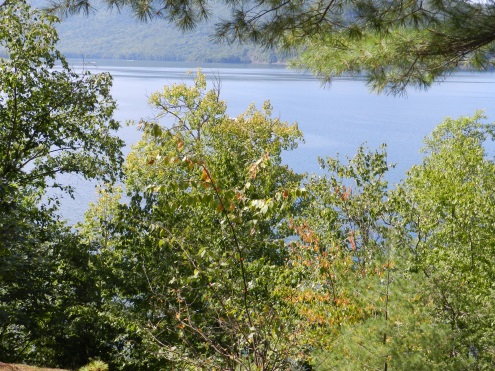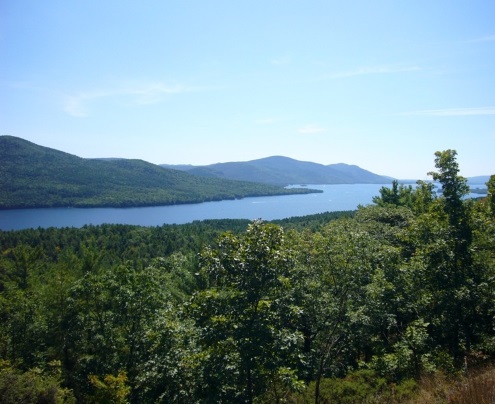
A picture from this past weekend, showing wisps from the lake feeding into low-flying clouds flowing to the north. (Click image to see larger view. Photo credit: Liam Ballantyne)
Great Gift Idea
Give the gift of nature with a Conservationist subscription, a New York State-focused #magazine that is packed with informative and entertaining articles, first-rate photography and stunning artwork!
Special 50% off sale now through #CyberMonday: https://t.co/pOOiOnqVO2 pic.twitter.com/odmN5Hi9Z7
— NYSDEC (@NYSDEC) November 21, 2018
C-130 Flight Down Lake George
A fun video taken from the cockpit of a C-130 flight down Lake George in August 2018. The video starts from the north coming in over Lake Champlain and Fort Ticonderoga and continues on a southerly path down Lake George.
LGLC Protects French Mountain
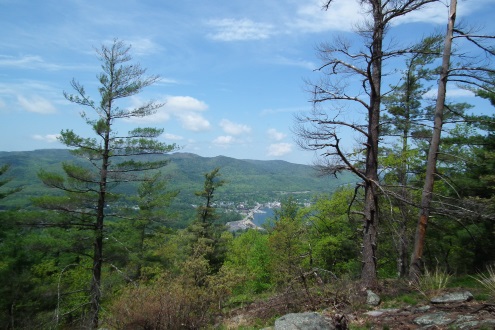
Photo of the view from the newly protected French Mountain property, looking west over the southern end of Lake George. © Alexander Novick, LGLC (Click image to see large view.)
On October 18, the Lake George Land Conservancy (LGLC) closed on the purchase of 317 acres on French Mountain, which lies within the Towns of Lake George and Queensbury, for $525,000. The LGLC will sell the property subject to a conservation easement to the Towns of Lake George and Queensbury; these transactions are expected to take place within the following months. The conservation easement will not only ensure that the land is protected, but also create a permanent relationship between the towns and the LGLC.
The protection of the land offers direct water quality protection. More than 2,000 feet of seasonal streams flow down the steep slopes of the property and join with East Brook far below. Zoning of the property would have allowed for the development of up to 15 new houses, potentially visible from I-87, Million Dollar Beach, resorts along Lake Shore Drive, and many other locations on the lake. In addition, these houses would have contributed to the runoff that flows into East Brook, and then into the south basin of the lake. Although the LGLC is not anti-development, the benefits to the watershed from protecting this particular land and retaining its natural state outweigh the possible value from development.
The property also offers another positive benefit: recreation. The towns plan to create a multi-use trail system on the property, which the LGLC will help to maintain. Because of its historical use for logging, the property has skidder trails throughout that could be used for hikers and mountain bikers. Although the trails would have a steep incline, the view from the lookout area will prove to be worth the effort. From the lookout area, those who have made the climb will be able to sit under the shade of the forest and catch their breath, taking in the expansive views of the lake, the village below, and the surrounding Adirondacks.
The property also provides a great link to the neighboring East Brook Preserve, which the McPhillips family sold to the LGLC earlier this year through a generous bargain sale. The Preserve contains wetlands and over 500 feet of the main branch of East Brook. The LGLC plans to develop a trail system and install educational signage at the property to explain how important land protection is to ensuring clean water in Lake George for generations to come.
The French Mt. project became the LGLC’s second great demonstration of how a land trust can successfully partner with municipalities for land conservation, and the shared goal of protecting Lake George. Similar to the LGLC’s partnership with the Town of Bolton to protect The Pinnacle in 2015, the LGLC brokered a cooperative agreement that benefits the lake as well as our partners’ communities.
LGLC Executive Director Jamie Brown said, “This project could not have happened without everyone involved being fully committed and dedicated to its success. We are grateful to the Towns of Lake George and Queensbury and to the McPhillips family, and look forward to other partnerships like this that will protect the land that protects the lake and create wonderful community resources.”
Queensbury Supervisor John Strough said, “The creation of a 317-acre jointly-owned French Mountain Park, is huge. This effort initiated by Lake George Town Supervisor Dickinson and LGLC’s Jamie Brown is going to be a boon for both Lake George’s water quality and our area’s recreational offerings. A beautiful property with beautiful views—flora, fauna, visitors and locals will love it.”
Bernice McPhillips, whose family owned the French Mountain property for over 90 years, expressed support for the land to be used as a recreational resource for the community. “The partnership with the Towns of Lake George and Queensbury and the hiking and biking trail system will have a very positive impact for the economy year round,” she said. “The beautiful view from the top is from the village straight up the lake and will most definitely be appreciated by the hikers and bikers using the trail system.”
New LGLC Leeming Jelliffe Preserve Opens in Huletts Landing
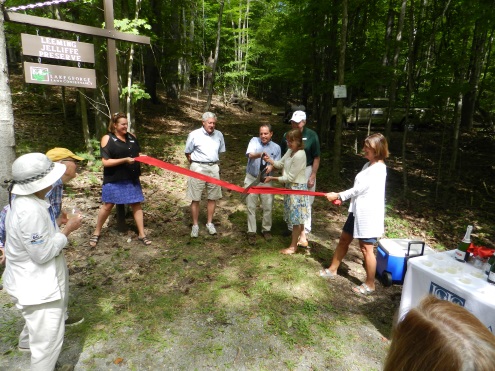
From left to right, at the ribbon-cutting ceremony of new Leeming Jelliffe Preserve in Huletts Landing: LGLC Development Manager Helen Barton Benedict, Paul Lawler, LGLC Executive Director Jamie Brown, LGLC Board President Mike O’Reilly, Sylvia Jelliffe Lawler, and LGLC Board Member Patty HasBrouck.
On Friday, September 7th, 2018 the Lake George Land Conservancy marked the opening of the Leeming Jelliffe Preserve in Hulett’s Landing with a ribbon-cutting ceremony attended by nearly 40 community members and key supporters of the project.
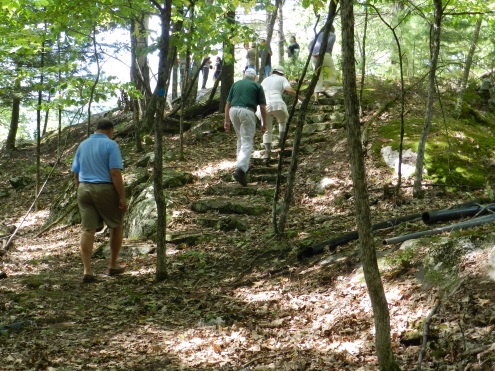
Visitors and guests enjoying the new trail system.
The 33.3-acre upland preserve was purchased by the LGLC in April. Over the summer, LGLC staff and volunteers blazed a short, easy trail to the preserve’s viewpoint overlooking the narrows and Silver Bay on the western shore. There is currently a small road-front area for parking; a larger parking lot may be created, if needed.
The purchase was made thanks to the willingness of the Wilkening family to work to protect it, and to a timely and generous donation by Paul and Sylvia Jelliffe Lawler, which was matched by Paul’s past employer, the W. K. Kellogg Foundation. The donation also made possible the purchase of a conservation easement on an adjoining house lot with over 600 feet of Lake George shorefront.
The Lawlers joined LGLC Executive Director Jamie Brown to cut the ceremonial ribbon at the preserve’s entrance on Bluff Head Road. Sylvia then spoke about her family’s roots at Lake George, and specifically, Hulett’s Landing.
Sylvia’s great-grandparents, and Helena “Bunny” Wilkening’s grandparents, Dr. Smith Ely Jelliffe and Helena Dewey Leeming Jelliffe, bought 125 acres of land in Hulett’s Landing in the early 1900’s. Over time the land was divided between their children; Bunny’s mother, Winifred, was given land that Bunny then inherited, including the property which is now the Leeming Jelliffe Preserve. The Preserve is named after Winifred’s brother, and Sylvia’s grandfather, William Leeming Jelliffe.

A reception followed the ribbon cutting at “The White House”, hosted by Paul and Sylvia Lawler.
“My grandfather, Leeming, died before my dad was born. He was a dearly beloved brother and he loved the lake. Dad was able to connect with his Aunts and Uncle here when I was young, and Lake George continues to be the strong thread that keeps us together. There is really something magical and comforting about this place, and its ability to keep people together.”
The LGLC also announced a new campaign, launched with a challenge pledge of $1 million from the Lawlers and Kellogg Foundation for conservation in the Hulett’s Landing area. The LGLC will be fundraising to match the generous pledge, so that $2 million in total will be available for permanent land protection in the region.
LGA’s Floating Classroom to Visit Huletts: Monday July 16th
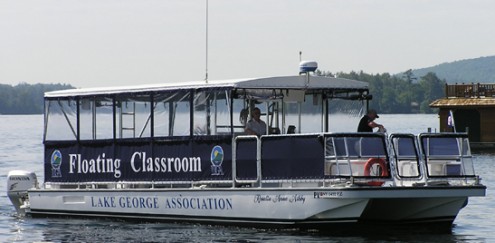
The Friends of Historic Huletts Landing is sponsoring a visit from the Lake George Association’s Flaoting classroom on Monday July 16th.
The LGA Floating Classroom will leave from the dock in front of the old Huletts Casino at 10:00 am. Please arrive 15 minutes early for an on-time departure and maximum time on the Lake.
Please help offset the cost by donating $15 per person. This event has been very popular in the past and we hope we can exceed the 34 people we had last time.
LGLC Awarded Grant for Indian Brook and Northwest Bay Brook Initiative
A view from the Wing Pond property.
The Lake George Land Conservancy (LGLC) has been awarded a $20,000 matching grant from the Cloudsplitter Foundation to be used to leverage new donations for land protection efforts within its Indian Brook/Northwest Bay Brook Conservation Initiative.
Specifically, the Cloudsplitter grant award will be put towards the acquisition costs of the 159-acre Wing Pond property, purchased by the LGLC in December of 2016. This property, which is within the scope of the Conservation Initiative, includes 15 acres of sensitive wetlands, 750 feet of stream corridor, important habitat for birds and wildlife (including critical rattlesnake breeding habitat), and four-season recreational opportunities for nearby communities and the public.
The Conservation Initiative focuses on a 7,500-acre complex of wetlands, streams and undisturbed forests that are within the subwatersheds of two of the Lake George’s largest tributaries—Indian Brook and Northwest Bay Brook. Sensitive lands within this area are critical to filtering millions of gallons of water before it enters the lake each year, but only if left in their natural, healthy state.
For example, studies indicate that although Indian Brook is showing some impacts from development and other human activity, the watershed is still below the threshold of containing less than 10% of impervious surface, which is an indicator of overall health. Much of the watershed’s sensitive land is currently unprotected, leaving water quality vulnerable.
To date, the LGLC and partners have protected 2,384 acres and 4,150 feet of shoreline within this area, an investment of more than $2 million. All of these properties contribute to the community’s overall health by providing protection of wetlands and stream corridors, as well as allow for public recreational opportunities. The LGLC has created and maintains more than 15 miles of recreational trails within this area.
This is the first grant the LGLC has received from the Cloudsplitter Foundation, which works primarily to improve the environment, both physical and cultural, in the Adirondacks and to make life easier, healthier, and more rewarding for the people who live there.
By funding the Wing Pond project, the Cloudsplitter Foundation is helping the LGLC to not only be able to further its conservation mission in this sensitive area but also to build on partnerships with landowners, communities and New York State. This project in particular represents over four decades of conservation work, and offers great conservation value, increased community and recreational value, and, as a match, leverage towards the greater Initiative.
State Releases Harmful Algae Bloom Action Plan for Lake George
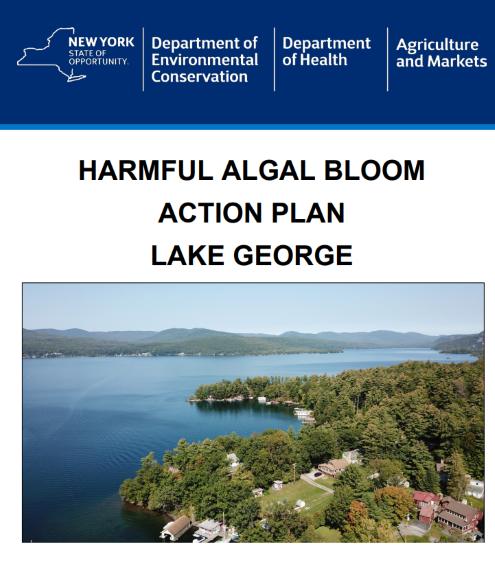
The state recently prepared an action plan for Lake George in regard to Harmful Algae Blooms (HAB’s).
Lake George was recently one of twelve New York lakes that was included in a study of harmful algae blooms. The 12 selected lakes represent a wide range of conditions, the goal was to identify factors that lead to Harmful Alage Blooms (HAB’s) in specific water bodies, and apply the information learned to other lakes facing similar threats. Each lake studied had an action plan prepared for that lake.
The good news from the report on Lake George:
“There have been no reported HABs in Lake George to date. Analyses conducted in this Action Plan provide insight into the processes that may potentially influence the formation of HABs in Lake George, and their possible spatial extents, durations, and intensities. Implementation of the mitigation actions recommended in this HABs Action Plan are expected to prevent the likelihood of blooms in Lake George.”
Additionally:
“Lake George is oligotrophic, rarely exhibits shoreline algal blooms, and there is no record of any HABs being observed or reported on the lake. Screening samples analyzed for algae, cyanobacteria, and algal toxin levels, including phycocyanin, and microcystin, by the State University of New York College of Environmental Science and Forestry (SUNY ESF) since 2012 found low overall algae levels and low cyanobacteria levels at each of the sampling sites (NYSDEC 2015). Cyanobacteria have been measured in benthic samples associated with Cladophora and other filamentous algae, but they have not comprised the major taxa in the phytoplankton community in these samples.”
However there is always room for more testing and vigilance:
“In summary, Lake George tends to have very low chlorophyll-a concentrations. However, there are some locations that tend to have consistently higher (though still low) chlorophyll-a concentrations relative to the rest of the lake (Figure 16). These locations include: Sandy Bay, Cotton Island, Basin Bay, Huletts Landing, Heart Bay, Weeds Bay, Asas Island, Lenni-Lenape Island, Arcady Country Cub, and the north end of the Lake around Prison Island. In these shallow areas the remote sensing might be picking other interferences as opposed to chlorophyll-a concentrations. Additional analysis may be of interest to investigate these locations further.”
The entire report for Lake George can be read here: https://www.dec.ny.gov/docs/water_pdf/georgehabplan.pdf
LGLC Protects Land in Huletts Landing

The Lake George Land Conservancy has purchased a parcel along Bluff Head Road which they intend to conserve.
The Lake George Land Conservancy (LGLC) has protected 37 acres in Huletts Landing, Washington County by purchasing a 33.3-acre upland piece and a conservation easement on the adjoining lower 3.7-acres lakefront property. As a result, this conservation project is providing permanent water quality protection by preventing the development of uplands directly above the lake, viewshed protection, and the addition of a small, family-friendly recreational opportunity.
Located on the eastern shore of Lake George, Bluff Head Road forms the approximate boundary between the two parcels that were sold by the Wilkening family. The lower property includes an old home (“the White House”), nearly 1/4-mile of stream corridor, and over 600 feet of Lake George shorefront. The upland property has an existing path leading to a viewpoint overlooking the narrows and Silver Bay on the western shore. The uplands also share a 1/2-mile boundary with Spruce Mountain, owned by New York State.
Current zoning would have allowed the construction of up to three homes on the larger parcel, and the smaller parcel could have been subdivided to allow for one additional home. However, the Wilkening family welcomed the possibility of protecting the land that has meant so much to them.
According to an oral history documented in 2010 by Friends of Historic Huletts Landing, the Wilkening family owned the property since the late 1800’s when Helena “Bunny” Wilkening’s grandfather, Smith Ely Jelliffe, bought 150 acres of land in the area. That land was then divided between his children; Ms. Wilkening’s mother was given the land that Ms. Wilkening enjoyed coming to for more than 80 years.
The conservation project was made possible thanks to the generous support and cooperation of Paul and Kaye Lawler, and Paul’s employer, the W. K. Kellogg Foundation, which matched their gift.
The Lawlers made a generous donation to the LGLC with the desire that it be used on future land conservation projects, to protect the land they love. As it turned out, this gift was just what the LGLC needed to move forward on the Wilkening project.
“I am thrilled to see my gift and the matching funds from the Kellogg Foundation being used on these great projects in Huelletts Landing,” Mr. Lawler said. “It’s a special place to me, and it will do so much good for the lake.”
“We are so grateful for the Wilkening family for working with us on this exciting project,” said LGLC Executive Director Jamie Brown, “and to the Lawlers and Kellogg Foundation for making it fiscally possible. It’s been more than 20 years since the LGLC has completed a conservation project in the Town of Dresden, and we’re pleased to once again be active in this tightknit community.”
“This is just the start of things to come in Huletts Landing,” Brown continued. “Foster Brook and other smaller tributaries flow through the area, which is mostly undeveloped. By protecting the surrounding land now we will safeguard the land’s natural ability to filter and manage stormwater for the health of Lake George. Additionally, we are looking into a number of other projects that will help to protect critical conservation values, including viewshed, in this part of the watershed.
The LGLC intends to make modest improvements to the uplands property to allow for minimal passive recreational use. A small parking area will be identified so as to not interfere with traffic on Bluff Head Road, and a short trail will lead to one or two picnic tables installed at the lookout area.
July 25th: Water & Light

I’m pleased to announce that on July 25, 2018, the Friends of Historic Huletts Landing is sponsoring; Timothy Weidner, Director of the Chapman Museum in Glens Falls, who will present an exhibit and lecture entitled: “Water & Light.” This unique presentation will focus on Sennaca Ray Stoddard images of Lake George from the 1880’s. Be sure to put it on your calendar now!
High Winds and Loose Ice
The ice is starting to break up on Lake George.
Extremely high winds caused all types of havoc in Warren county and Washington county yesterday. Trees and power lines were down and ice is being pushed around the lake as it breaks up.
Large chunks of ice in many bays, as it is pushed toward shore by the high winds.
$54,500 Repair By LGA, Town of Dresden Will Improve Water Quality In Huletts Landing
To Good to Check: Guess Where Alien Hunters Think They’ve Found a UFO?
Because any alien would want to stop at Lake George!
Many have seen the UFO after the Casino closes.
Champlain Power Express Hopes to Lay Power Line Through Dresden
The Champlain Power Express is a project you will hear about over the next few months as the developers hope to run an underground electricity transmission line 333 miles from a substation in Canada to a substation in Queens New York, with the goal of supplying additional power to New York City.
The project has been years in the works, starting in 2009. The proposed route would take the line underground through Dresden along state Route 22. It would only carry electricity that would be generated almost exclusively in hydroelectric plants in Canada. It would not carry gas, fuel oil or other hazardous materials.
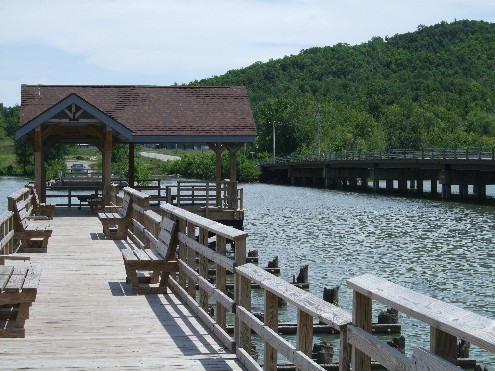
The proposed route would take the planned transmission line underground through Dresden to Whitehall near the South Bay bridge.
The project would bring additional tax revenue to the Town of Dresden, Washington county and the Whitehall school district because the transmission line becomes a taxable asset when it is placed in the ground. More details coming soon.

